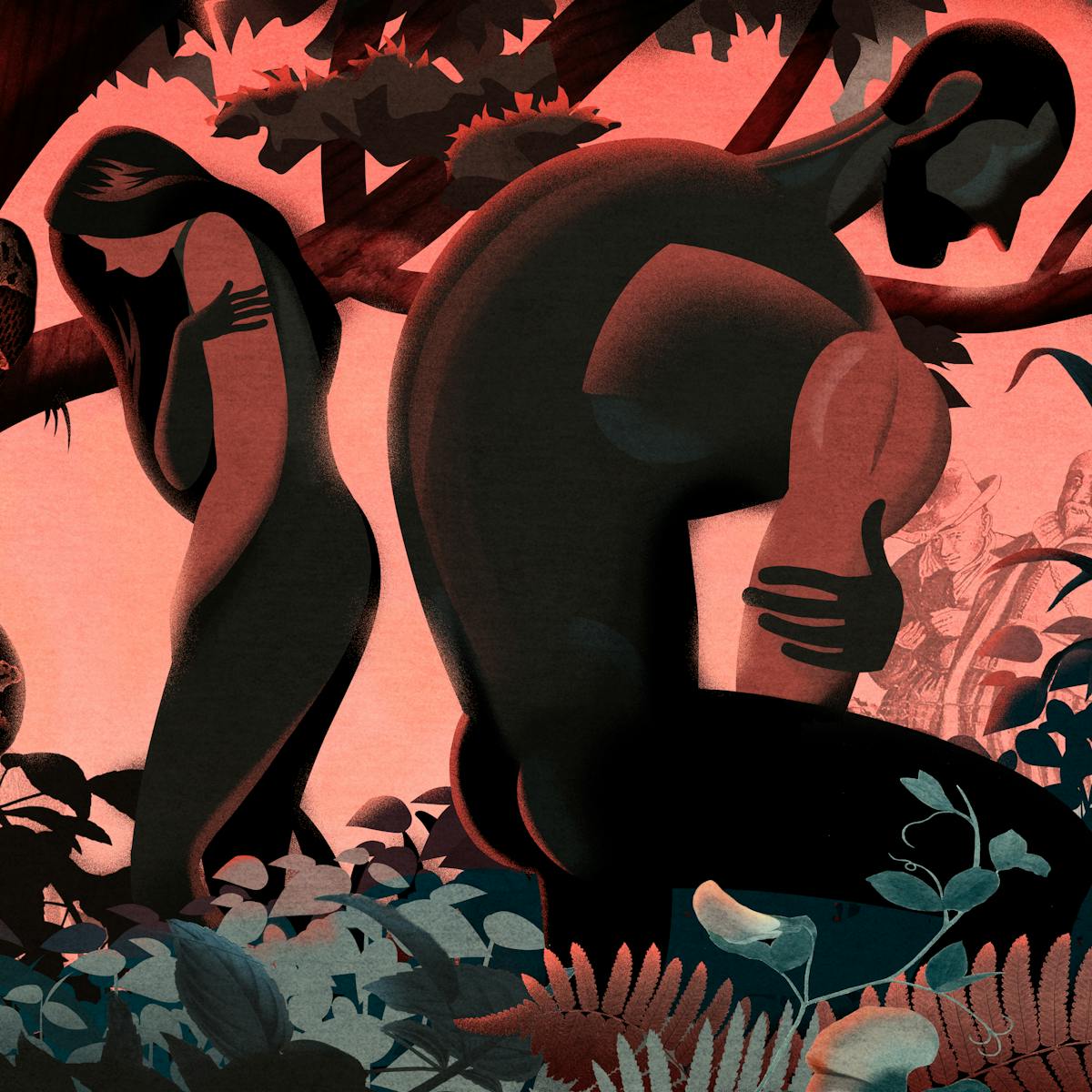Lucia Osborne-Crowley knew she would be blamed and shamed after being sexually assaulted, and so she kept quiet. But where does the feeling the body is shameful and needs to be hidden come from? And what fuels shame? Lucia explores audience, gender and the difference between shame and guilt, asking if either can ever be useful.
Shame, condemnation and conscience
Words by Lucia Osborne-Crowleyartwork by Eduardo Rubioaverage reading time 6 minutes
- Serial

I knew from the moment I was raped that I must never tell anyone what had happened to me. I didn’t think about it consciously, but I knew in my bones I had done something terribly wrong. I knew that I wouldn’t be believed. I knew that I had transgressed.
As soon as I got home, I ran steaming hot water in the shower and stood underneath it. Blood and water pooled around my feet, until everything was hot and burning and crimson.
When I got out of the shower, I stared at myself in the mirror. I had bruises across my stomach from where my attacker had pushed and elbowed me, had held me against the wall. My first thought was, How can I make sure no one sees these bruises? I knew they would take at least a week to heal.
I didn’t know at the time, but in those moments my brain was creating and reinforcing a powerful neuropathology that would define me for the first ten years of my adult life: the connection between sex and shame, and the knowledge that my body is shameful and needs to be hidden.
The fundamental things about shame
In Christian cultures, shame is a fundamental part of the founding myth. In the first pages of the Bible, we learn that Adam and Eve are “naked, but they are not ashamed”. But, once they have tasted the apple from the tree of the knowledge of good and evil, “the eyes of both of them were opened, and they knew that they were naked”.
As soon as they know they should feel it, Adam and Eve are engulfed in shame. There are multiple depictions of this scene in art and literature, one of the most powerful being Masaccio’s ‘Expulsion from the Garden of Eden’, where Adam covers his face while Eve closes her eyes, shielding her breasts and genitalia with her hands.
In the ‘Iliad’ – one of the earliest known works of Western literature – Agamemnon is begged by his wife to stay out of battle, to stay safe to help raise his child. But he insists “my shame before the Trojans… would be too terrible if I hung back from battle like a coward”.
These early stories point to two fundamental things about shame: it requires an audience, and it is gendered. In the Bible story both Adam and Eve feel shame, but Eve bears the greater burden, having allowed Satan to deceive her.
The imagined gaze
Shame is rooted in the belief that we have been witnessed, or could be witnessed, doing something someone else will condemn us for. The imagined gaze can be just as powerful as a real one. I expected to be blamed for my rape, so I remained silent and the shame grew.
Shame looks different depending on who is carrying it. One of the major organising principles of shame that research professor Brené Brown has discovered is that it is heavily gender-dependent.
In her book ‘Men, Women and Worthiness: The Experience of Shame and the Power of Being Enough’, Brown interviews people about the things that trigger shame in them. Those who identified as men and those who identified as women gave very different answers.
For female-identifying participants, the societal standards that trigger shame can be boiled down to this: the expectation is to be small, pretty and nice. For male-identifying participants, the expectation is to be strong, emotionally stoic, and to not show weakness.
Pretty. Nice. Tough. Strong. These are not the attributes of emotionally complex human beings, all of whom exist on a spectrum of gender identity that is fluid both between and within us. And here’s what else the research shows. Shame is attached to these qualities regardless of whether the person believes them to be valuable or important.
Shame is not the same as guilt
Shame and guilt should not be confused, although they often are. Guilt is attached to a specific action or behaviour. It is the sense that we have done something immoral or wrong, but it does not equate that act with who we are as a person. It holds the act outside of who we are and says: I did something I regret.
In fact, guilt relies on having a robust, healthy sense of self. Guilt can only survive if we decide our actions are unworthy of our character; that they are morally beneath us. We must have a sense of worthiness in order to feel guilty.
In the words of Brené Brown: “Guilt says, ‘I made a mistake.’ Shame says, ‘I am a mistake.’”
Shame burns brightest when we have a sense that we have failed to meet an expectation that society has of us.
Guilt assesses our behaviour against our ideas about the world, and then nudges us with feelings of regret when we find the two don’t match up. Shame is handed to us by others. It burns brightest in our minds when we have a sense that we have failed to meet an expectation that society has of us.
Can shame ever be useful?
Even though shame and guilt are usually experienced differently, guilt about something we have done can trigger shame and make us question the core of ourselves. In this way, shame can be crucial to the development of conscience. It can help us understand when we have done something that has caused another person to suffer.
The psychologist John Amodeo explains: “While shame can be debilitating, it can also be an early warning system for when we’re poised to break trust and injure a person.”
Amodeo offers a useful answer to the question of how we hold on to the aspects of shame that help us develop a moral compass while keeping the toxic aspects of shame at arm’s length. He says it is all about pausing and noticing the emotion as soon as we feel it.
In the moment, we can ask ourselves whether we think we are feeling “toxic shame” – in Amodeo’s example, something like “you are not entitled to express your wants and needs” – or “friendly shame” – which sounds more like: “Stop! You are about to hurt someone you love.”
In her book ‘Is Shame Necessary?’, Jennifer Jacquet argues that in a hyper-individualised Western – and particularly American – culture, shame can be useful in its ability to reinvigorate the power of collective consciousness. The approbation of the group can lead to important changes in behaviour – around climate change, for example – that cannot be achieved through the more individualistic experience of guilt.
Like anything worth talking about, the utility of shame is complicated. But I am confident that if we pay attention to shame – if we notice it, investigate it and discuss it – we can learn to distinguish between its useful and destructive manifestations, and free ourselves from the shame that freezes us.
About the contributors
Lucia Osborne-Crowley
Lucia Osborne-Crowley is a writer and journalist. Her first book, ‘I Choose Elena’, was published in 2019. Her second book, ‘My Body Keeps Your Secrets’, will be published in 2020. Her news reporting and literary work has appeared in Granta, GQ, the Sunday Times, HuffPost UK, the Guardian, ABC News, Meanjin, The Lifted Brow and others.
Eduardo Rubio
Eduardo Rubio is a Mexican-born artist and illustrator living in Madrid. His work mainly involves collaboration with publishing houses and brands; he also works on personal projects, which he exhibits in galleries and museums.

